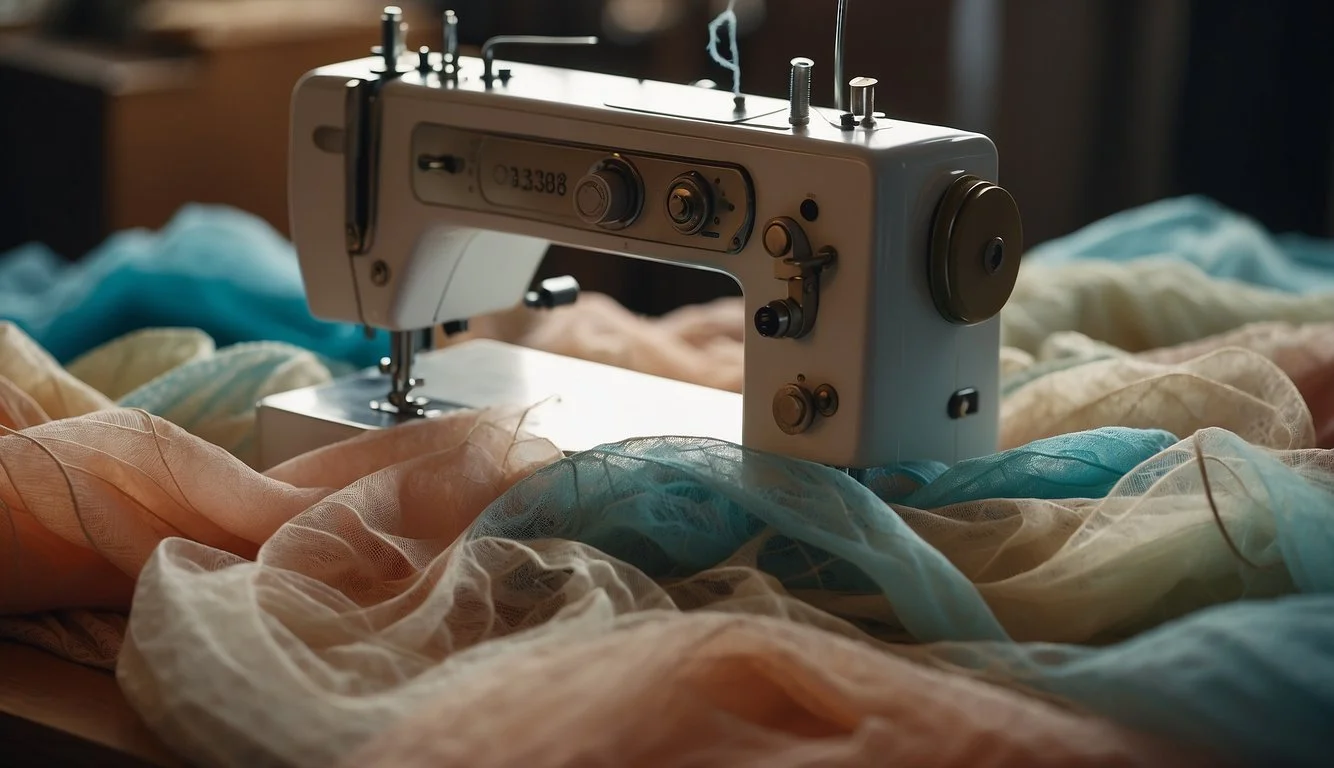Creating Your Perfect Prom Dress I’ve invested many hours gathering tips and techniques to help you craft a unique prom dress that showcases your individual personality and style, making sure you shine during your special night.
Key Takeaways
- Creating a prom dress offers a personalized touch to a significant event.
- Attention to detail in design and fitting ensures a flattering and unique result.
- The process of making a prom dress embodies individual style and fashion creativity.
Choosing Your Dress Style and Fabric

When I’m crafting a prom dress, my primary focus is on the cut of the dress and the material it’s made from. These two aspects will largely dictate the overall look and feel of the dress.
Understanding Dress Silhouettes
I pay close attention to silhouettes, as they define the dress’s shape and how it fits my body. Some popular styles include:
- A-Line: Fitted at the hips and gradually widens towards the hem, flattering for most body types.
- Mermaid: Contours to the body from the chest to the knee, then flares out.
- Ball Gown: Features a fitted bodice and a dramatic flared skirt.
- Empire Waist: Has a raised waistline just below the bust, ideal for a taller appearance.
- High-Low: A higher hem in front and longer in the back for a modern twist.
For each style, I consider how it will interact with the fabric and color I choose, as well as details like the neckline and whether or not I’ll include a train.
Selecting the Right Fabric
The fabric can utterly transform the look of a dress, so I mull over this choice thoroughly. Here are some fabrics I love working with:
- Lace: Adds a touch of elegance and grace, perfect for delicate overlays.
- Satin: Provides a smooth, glossy surface, exuding a luxe vibe.
- Tulle: Light and airy, tulle brings a dreamy quality to fuller skirts.
- Silk: Known for its luxurious feel and natural luster, silk drapes beautifully.
- Chiffon: Lightweight and sheer, chiffon lends a soft and ethereal feel.
- Velvet: Its plush texture is perfect for adding drama and warmth to winter prom dresses.
A fabric’s weight and flow are crucial to how it will move and feel – for a comfortable and flattering fit, I always consider these.
Picking the Perfect Color for You
The color of the prom dress is the first thing people notice. I think about the following when choosing:
- My Skin Tone: I choose colors that complement my natural hues—cool tones for cooler complexions and warm colors for warmer ones.
- The Event Atmosphere: Vibrant colors for high-energy events, and pastels or darker shades for formal affairs.
- Season: I consider the time of year—pastels for spring, jewel tones for fall, etc.
For the perfect match, I also examine fabric swatches in different lights to see how they might look in the prom venue. This ensures the chosen color truly flatters and stands out in the desired way.
Design and Pattern Preparation

When I begin working on a prom dress, design and pattern preparation are crucial first steps. I focus on achieving a perfect fit and a personalized style that flatters my body type and matches my vision for the special night.
Taking Accurate Measurements
I take precise body measurements before selecting a dress pattern to ensure a perfect fit. For a strapless dress with a waistband or any other style, I measure my bust, waist, hips, and length from the top of my shoulder to the floor. I use a soft tape measure for accuracy and record these in inches.
Finding and Adjusting Patterns
Once I have my measurements, I look for dress patterns that closely align with my size. Brands like Butterick, Vogue, and Simplicity offer a variety of patterns, which sometimes include free patterns. If I cannot find an exact match, I adjust the pattern by resizing the pieces, especially for areas like the bust or waist, to complement a plus-size formal dress pattern or any other specific body type.
Customizing Your Dress Design
I believe that designing a prom dress is a way to express my unique style. Whether it’s a wrap dress with straps or a different silhouette, I choose a fabric that reflects my personality. Luxurious silk is my favorite for an elegant look. I also modify existing patterns to add personal touches, such as changing the neckline or adding embellishments to make my prom dress one-of-a-kind.
Sewing and Assembling the Dress

Cutting and Marking Fabric
Before I start sewing, it’s essential to carefully cut and mark the fabric to ensure all pieces will fit together seamlessly. I lay out my fabric flat, place the pattern on top, and secure it with pins. Double-checking the grain of the fabric aligns with the pattern’s grainline is crucial. Using tailor’s chalk or a fabric marker, I transfer any pattern marks—like darts or notches—onto the fabric. Then, I meticulously cut out the pieces with sharp dressmaking shears.
- Notes on Fabric Cutting:
- Make sure the fabric is on grain.
- Pin pattern pieces securely.
- Double-check the layout before cutting.
- Transfer all pattern marks accurately.
Sewing Basics and Techniques
When sewing the dress, I rely on my trusty sewing machine for most of the work, setting it up with the correct stitch settings and needle for my fabric type. I always start by sewing the more straightforward parts, such as the side seams, before moving on to more complex features like inserting the sleeves or zipper. Patience is key when I’m working with finicky details like the fitted bodice or setting in the boning for a corset effect—it’s what makes the dress unique and professional looking.
- Key Sewing Techniques:
- Use the right stitch length and tension.
- Reinforce seams with backstitching at the start and end.
- Press seams with an iron for a crisp finish.
Adding Detail and Embellishments
The final step is all about creativity: adding embellishments to give my dress its flair. I hand-sew beads, sequins, and crystals to create beautiful patterns that catch the light. When working with lace, I might use fabric glue to help position it before stitching it down. Delicate details like these can transform a simple gown into a stunning prom dress that stands out in a crowd.
- Embellishment Ideas:
- Sew on beads and sequins in a decorative pattern.
- Attach lace trims along the hem or bodice.
- Use fabric glue judiciously for delicate appliqués.
With these techniques, notions, and a bit of magic from my needle and thread, my prom dress will be ready for twirling on that special night!
Final Touches and Fitting

When crafting my DIY prom dress, the final touches and fitting are crucial steps that ensure the gown looks stunning and feels comfortable. These last adjustments make all the difference for that picture-perfect, flattering fit.
Adjustments and Alterations
After piecing together the main components of my dress, I often find some adjustments necessary. These alterations require meticulous attention, whether it’s taking in a side seam for a more fitted look or adding fabric to areas that might need a bit extra room. For a sleeveless design, I might adjust the armholes to avoid any gaps, while for long sleeves or cap sleeves, ensuring a good sleeve fit without restricting movement is key. If my dress includes a zipper, I double-check that it lays flat and doesn’t bunch. For my plus-size formal dress, I focus on creating a silhouette that is both comfortable and flattering, which sometimes means adding strategic darts or choosing a stretch fabric for a better fit.
Dress Fittings and Comfort
I schedule at least one or two dress fittings to ensure my DIY prom dress fits well. Comfort is paramount for a long evening of dancing and socializing. During fittings, I move around to test the ease of the dress: sitting, walking, and dancing should all be easy without any restrictions. It’s not just about looking good; I need to feel good, too. If my dress is fitted, I make sure it’s not too tight, especially around the waist and hips. If I’m going for a looser style, I keep an eye on the bust and shoulders so the dress stays in place without slipping. Proper fit contributes significant comfort, and confidence comes with knowing my DIY project has come together flawlessly.
FAQ – How to Make a Prom Dress?
What skills do I need to make a prom dress?
Basic to intermediate sewing skills are needed, including knowledge of sewing techniques, understanding patterns, and working with different fabrics. Experience with fitting garments and making adjustments is also beneficial.
How do I choose a pattern for a prom dress?
Select a pattern that matches your skill level and style preferences. Consider the dress silhouette, length, and detailing. Patterns can be found in fabric stores, online, or you can even design your own if you have the experience.
What type of fabric is best for a prom dress?
The fabric choice depends on the dress style and personal preference. Popular options include satin, chiffon, tulle, and lace. Consider the fabric’s drape, weight, and how it complements the dress design.
How much fabric will I need for a prom dress?
The amount of fabric needed will depend on the dress pattern, size, and style, especially if the design includes a full skirt or train. Most patterns provide fabric requirements. It’s a good idea to purchase a little extra for any mistakes or adjustments.
If you enjoyed reading about How to Make a Prom Dress?, check out our other articles:
- 8 Elegant Prom Dress Trends 2025: Glamour Unleashed!
- 11 Green Prom Dress Trends: 2025’s Must-Have Styles!
- 7 Top Gold Prom Dress 2025: Shine Bright on Your Big Night!
- 10 Yellow Prom Dress 2025: Find Your Sunshine on the Dance Floor!
- 7 Hot Pink Prom Dress Trends: 2025’s Dazzling Styles!
Feel free to also check out our other Articles about School Events from the category “School Life“ and don’t forget to follow us on Pinterest.

